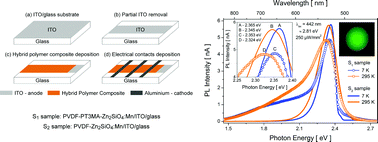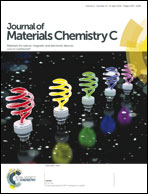Synthesis and evaluation of a PVDF–PT3MA–Zn2SiO4:Mn hybrid polymeric composite for optical device applications
Abstract
A new hybrid organic/inorganic composite consisting of poly(3-thiophene methyl acetate) (PT3MA), poly(vinylidene fluoride) (PVDF) and manganese-doped zinc silicate (Zn2SiO4:Mn) has been synthesized and applied for the fabrication of an optical device. Recrystallized PVDF was used as a host matrix for the PT3MA polymer and Zn2SiO4:Mn inorganic compound. The active layer was deposited on an indium-tin-oxide (ITO)-coated glass substrate by the drop casting technique. A spin-coating method was also used for morphological comparison purposes. The synthesized material as well as the device (aluminium electrodes/PVDF–PT3MA–Zn2SiO4:Mn/ITO/glass) was characterized by scanning electron microscopy (SEM), atomic force microscopy (AFM), energy dispersive X-ray spectroscopy (EDX), dark current–voltage (I–V) characteristic curves, absorbance and photoluminescence (PL) spectroscopy. The results show spherical- and irregular-shaped microparticles both dispersed on and within the PVDF matrix, which correspond to PT3MA and Zn2SiO4:Mn, respectively. The hybrid composite shows strong luminescence at ≈525 nm superimposed by a broadband between 600 and 800 nm, originating from the Zn2SiO4:Mn radiative transitions and from the recombination of photogenerated carriers at PT3MA. At room temperature, the device presented semiconductor behaviour typically observed for photodetectors and a DC electrical conductivity of ≈0.37 μS cm−1.


 Please wait while we load your content...
Please wait while we load your content...